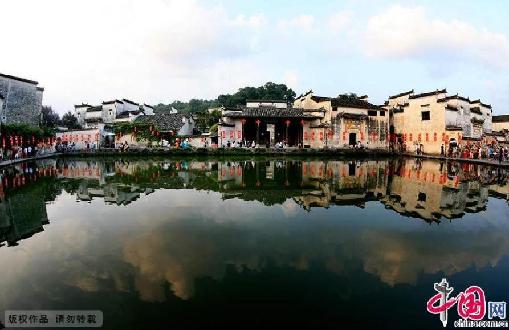Ancient Villages in Southern Anhui – Xidi and Hongcun
 0 Comment(s)
0 Comment(s) Print
Print E-mail China.org.cn, January 19, 2015
E-mail China.org.cn, January 19, 2015
The time-honored residential buildings of Yixian County, located at the foot of Mt. Huangshan, Anhui Province, have long been regarded as typical examples of Anhui-style architecture. There are 29 Ming Dynasty (1368-1644) and 3,611 Qing Dynasty (1644-1911) residential buildings and family temples in the county. Decorated with the typical local style of brick, wood and stone, carvings, they display the ornateness and elegancy of the traditional 15th-16th century edifices, boasting historical and research value, as well as being tourist attractions. The most typical of these are the residential houses of Xidi Village and the paleo-ox-shaped Hongcun Village. They have been referred to as museum of Ming and Qing residential houses in China.
Xidi Village is located in the southeastern part of Yixian County and has over 300 simple, yet graceful, Ming and Qing dynasty residences, of which 124 are well preserved. The village streets and lanes with their original style remain as they have done for centuries, and the village has been praised by foreign architects as containing some of the best preserved old-time houses and as being one of the most beautiful villages in the world. Typical structures in Xidi include a pailou to the residence of the Qing prefectural governor Hu Wenguang, the Ruiyu Courtyard, the Taoli (peaches and plums) Garden, the Dafu Grand House (home of a senior official in feudal society), and Lingyun Tower.
Hongcun Village is about 11 km from the county town of Yixian County. The whole village was originally laid out in the shape of an ox. The west end of the village, called Leigang Hill, resembles an ox head and that is where two huge trees stand like ox horns. At the front and rear of the village are four bridges that span a Jiyin stream and resemble four legs of the ox. The several hundred well-arranged houses form the body of the ox, and the 1,000-meter-long Jiyin stream that meanders through the village is regarded as its intestines. A crescent pond in the village is the ox's fourth stomach, and a larger South Lake is its reticulum, the second stomach. The villagers of Hongcun long ago designed this marvelous landscape.
On November 30, 2000, Xidi and Hongcun were chosen to be placed on the List of World Cultural Heritage sites by UNESCO.






Go to Forum >>0 Comment(s)